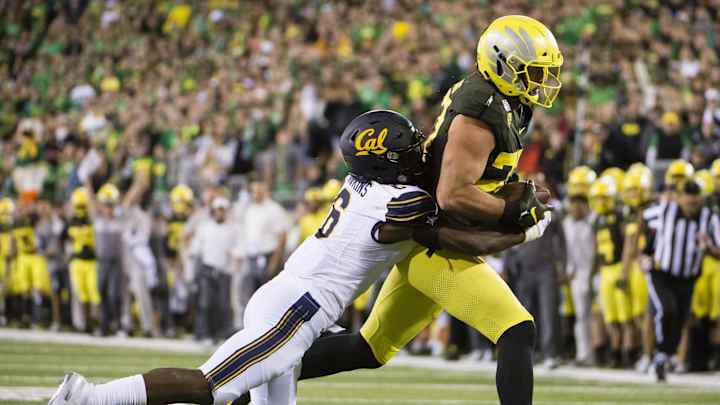What Will a Pac-12 Conference-Only Football Schedule Look Like?

OK, now comes the tough part.
The Pac-12 announced on Friday that its football teams will only play Pac-12 opponents in 2020, so what will that schedule look like?
Myriad scenarios are on the table, and the conference said on Friday it will release schedule details no later than July 31.
Before we get to schedule possibilities, the conference has to establish some ground rules regarding COVID-19 testing, game eligibility and attendance.
The NCAA Division I Oversight Committee may establish some rules as far as testing protocols and information sharing, but presumably the Pac-12 will set up strict guidelines of when and how testing should be conducted by its members and the information that must be made public.
Questions arise if football players or coaches test positive during the season:
How many players on a team can test positive without disqualifying that team from participating in the ensuing game? Are 50 eligible players enough? Are 45?
Once an arbitrary number is established, what happens if a team does not have the minimum number of healthy players available for a given game?
---Is the game canceled? That messes up the schedule for everyone in the conference, especially the opponent of the team that does not have enough healthy players.
---Is the game postponed? As you will see later, finding a date both teams can play will be a major problem. One option is to build in open dates for one or two Saturdays late in the season when postponed games could be played.
---Does the team without the required number of healthy players have to forfeit the game? You can see the possible ramifications of this, including the incentive to fudge on tests and testing information.
The final issue is whether spectators will be allowed to attend games, and will one rule apply to all Pac-12 schools or will it vary based on the number of COVID-19 cases in the area where the game will be played?
Whether the ACC, Southeastern Conference and/or the Big 12 also go to conference-only schedules would affect what the Pac-12 decides to do. All five Power 5 Conferences should agree to play the same number of games to make things fair, but with no one to legislate that decision it’s possible one conference could play more games than another.
Let’s assume these issues are ironed out to the satisfaction of the Pac-12 schools. What are the possible schedule scenarios:
1. Simply eliminate the nonconference games and play the nine conference games and Pac-12 championship game as currently scheduled.
That would be the easiest logistically, but it has shortcomings. The most obvious problem is that two conference games – Stanford at Arizona on Sept. 12 and USC at Stanford on Sept 19 – are scheduled before the bulk of conference play begins on Sept. 26. The Stanford-USC game could be rescheduled for Nov. 28 because both teams were scheduled to play nonconference opponents that day. But there is no rescheduling option for the Arizona-Stanford game.
Playing the Arizona-Stanford game as scheduled on Sept. 12 does not seem to be an option, because the Pac-12 has said it wants to delay the start of the season (reportedly because the coronavirus situation in Los Angeles would prevent USC and UCLA from being ready to play).
Perhaps the conference could substitute one of the two Pac-12 teams Stanford or Arizona is not scheduled to play this season, but neither of the conference teams Stanford is not scheduled to play this season (Utah and Arizona State) has an open date that would work for Stanford.
In any case, playing just nine games would be a concern, as we look at option No. 2.
Percentage chance of this option being chosen:
Jake: 4 percent
Jeff: 5 percent
.
2. Blow up the existing schedule and start from scratch so that every team plays the same nine conference opponents it was scheduled to face, with the schedule starting at an agreed-upon date, perhaps Sept. 26 or Oct. 5.
That can be accomplished without too much trouble, but there are problems.
Playing only nine games would limit whatever revenue schools could generate. More significantly it might prevent the conference champion from earning a berth in College Football Playoff.
Robbed of its opportunity to prove its worth against nonconference opponents, Pac-12 teams would face the ongoing perception that their conference simply is not as good as the other four Power 5 conferences.
You wonder whether a 9-1 Pac-12 team (with a conference title-game victory) would get the nod over a, say, 11-2 Big 12 team if that conference plays a full schedule.
Percentage chance of this option being chosen:
Jake: 20 percent
Jeff: 25 percent
.
3. Blow up the schedule and have a complete round-robin in which each Pac-12 team plays every other conference team for an 11-game season.
In Cal’s case, that would mean adding Arizona and Colorado to the schedule.
Assuming the Pac-12 holds to its intention of delaying the start of the season, the addition of two games would push a Pac-12 championship game back to late December or early January, eliminating bowl-game opportunities and pushing up against the national semifinals, if it is played as scheduled.
Playing 11 games, rather than nine, might make the record of the Pac-12 champion more attractive, but would not improve the national perception of the Pac-12 when it comes to choosing the four College Football Playoff qualifiers. Would an 11-1 Pac-12 champ look better than a 9-2 or 10-2 Big Ten runnerup to the CFP selection committee?
(The Big Ten and Big 12 both play nine conference games, like the Pac-12, but the SEC and ACC play just eight, as it stands now. Who knows what those conferences will settle on, but it would solve a lot of problems if the five conferences agreed on the number of games it will play this season.)
Percentage chance of this option being chosen:
Jake: 25 percent
Jeff: 15 percent
.
4. Delay the start of the season further.
A nine- or 11-game season that starts in, say, November presumably would provide a safer and more predictable environment for football than we have now. Fans might even be allowed in the stands by then.
It would put the Pac-12 championship game on January 1 or 2, 2021, for a nine-game season with no byes and January 15 or 16, 2021, if an 11-game conference schedule were played with no byes.
The potential conflicts with postseason games are obvious.
Percentage chance of this option being chosen:
Jake: 23 percent
Jeff: 30 percent
.
5. College football opts to play a spring schedule.
This option has been mentioned more often lately, with the recent rise in coronavirus cases, but always as a last resort.
To have a national championship game played by mid-June, the spring football season would need to start around March 20, the heart of basketball’s March Madness.
Two problems:
---Players expected to be taken in the 2021 NFL draft (scheduled for April 29-May 1) would not play. That’s a lot of star players taken out of the picture.
---The end of the spring season would run too close to the start of the 2021 season the following fall. Having the 2021 training camp just a few weeks after the end of the spring season may be asking too much of 18-to-22-year-olds in a sport as physical as football.
Percentage chance of this option being chosen:
Jake: 8 percent
Jeff: 5 percent
6. The 2020 college football season is canceled before it starts.
College athletic departments would lose millions of dollars they were counting on and would be forced to cut multiple nonrevenue sports.
Percentage chance this option is chosen:
Jake: 5 percent
Jeff: 10 percent
.
7. A fall college football season is interrupted midway through by a rise in COVID-19 cases among athletes, and the rest of the season is canceled.
Unforeseen consequences arise.
Percentage chance this occurs:
Jake: 15 percent
Jeff: 10 percent
.
.
Cover photo by Troy Wayrynen, USA TODAY Sports
.
Follow Jake Curtis of Cal Sports Report on Twitter: @jakecurtis53
Find Cal Sports Report on Facebook by searching: @si.calsportsreport
Click the "follow" button in the top right corner to join the conversation on Cal Sports Report on SI. Access and comment on featured stories and start your own conversations and post external links on our community page.
